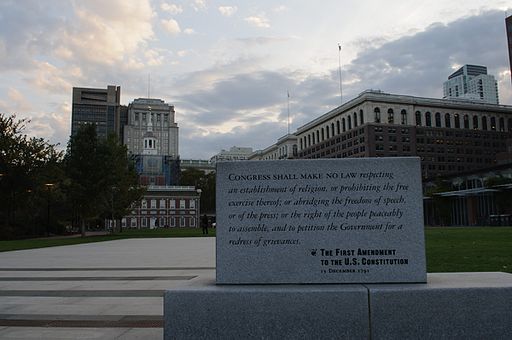Future of the First Amendment Forecast Partly Cloudy with the Chance for Rain
by Shawn Healy, PhD, Civic Learning Scholar
The Trump presidency has simultaneously inspired a new protest movement and galvanized a press corps labeled “enemies of the people.” Both rely on constitutional protections embedded in the First Amendment, and a recent survey sheds light on students’ perspectives on the importance of the “five freedoms.”

According to the 2016 survey funded by the Knight Foundation titled “Future of the First Amendment,” student support is at a ten-year high. Ninety-one percent of high school students agreed that “people should be able to express unpopular opinions,” up from 83% in 2004.
Students and their teachers differ when asked if the “First Amendment goes too far in the rights it protects.” While 56% of students answered in the affirmative, three-fourths of teachers (75%) took the same position.
Nearly two-thirds of students (64%) believe that freedom of speech should prevail over “protecting someone from being offended.” But a majority of students disagree that “people should be able to say what they want if it’s offensive to others…” in public (59.1%) and on social media (65.4%). Likewise, bullying in either venue garners little support (36% in public and 30% on social media).
Among those students supportive of the First Amendment “right to offend,” they are more likely to discuss news with others on social media, seek news on their mobile devices, and also to use online videos as a news source. It’s also interesting to note that there’s a gender divide when it comes to social media as a news source: females are much more likely to consume news here (58% versus 46%).
Most students (65%) believe that individuals have the same right to post photos, videos, or other documentation of a public event on social media as journalists, yet they are less likely to say that these parties should follow through with sharing such information publically (44% and 39%, respectively).
While a plurality of students (45%) find legacy media sources (TV and newspapers) more trustworthy than social media, 29% deem them equally trustworthy and more than a quarter (26%) lend more credence to social media. Their teachers, by comparison, are much more partial to legacy media sources (68% consider them more trustworthy).
All of this analysis considered, only a third of students personally think about First Amendment freedoms, whereas 35% take them for granted and 32% admittedly don’t know much about them. This leaves much work for us as educators while First Amendment freedoms are exercised and tested more acutely than any time since the Vietnam War and the Nixon presidency.




Comments
Post a Comment